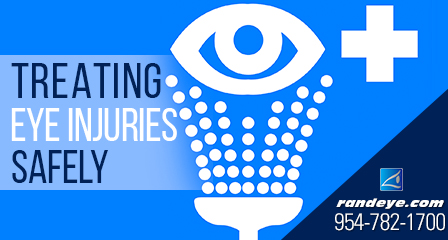We’ve had a lot of positive feedback on our last article about wearing proper protective eye equipment (PPE) when performing tasks that could be hazardous to your eyes. As we learned, there are only so many things in life that you can control, and wearing eye protection is one of them.
But what happens when you suffer an eye injury that is beyond your control?
The American Academy of Ophthalmology and Rand Eye Institute present some of the ways you can treat various eye injuries.

First step FOR ALL EYE INJURIES:
- Do not touch, rub or apply pressure to the affected eye.
- Do not try to remove the offending object from the eye.
- Do not apply ointment or medication to the eye.
- See an ophthalmologist or a medical doctor as soon as possible.
For a cut or puncture of the eye:
- Do not rinse with water.
- Do not remove the wedged/protruded object from the eye.
- Do not rub or apply pressure.
- Try loosely taping a paper cup or eye shield over the eye for protection; then seek help from a medical professional.
- Do not take aspirin, ibuprofen or other non-steroidal, anti-inflammatory drugs as these thin the blood and may increase bleeding.
For a liquid substance in the eye, or a chemical burn:
- Rinse your eye under a steady stream of warm, fresh water for 15 minutes. Just let it run into your eye and down your face.
- After rinsing, you can put a cool, moist compress or an ice pack on your eye, but don’t rub it.
- Call your eye doctor or emergency clinic to ask what is recommended for your injury. Tell the person what kind of substance got into your eye and what you’ve done about it so far.
A direct hit to the eye, from a ball or hard object:
Apply a small cold compress, gently, to reduce pain and swelling. Do not apply any pressure.
If a black eye, pain or visual disturbance occurs after a light blow, contact your eye professional or visit an emergency room right away.
Getting particles or foreign materials in the eye:
- Do not rub the eye.
- Carefully lift your upper eyelid. Blink several times to allow tears to flush the particles. If you have sterile eye drops, try using them. If the particles remain, keep the eye closed and seek medical attention right away.
As a precautionary measure, contact your ophthalmologist or eye doctor for additional assistance. Your doctor may need to see you right away, or suggest you visit an emergency clinic at once. It’s always safest to have someone drive you, even if you think you’re ok to drive. Always err on the side of caution because we only get ONE pair of eyes.
